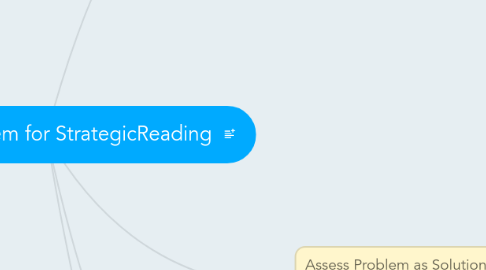
1. Assess Problem as Difficulties
1.1. Ascertain Consequences
1.1.1. Important facts overlooked
1.1.1.1. ...follows from...
1.1.1.1.1. Loss of opportunity
1.1.1.1.2. Overconfident problem analysis
1.1.2. Lack of engagement
1.1.3. Poor reference recoverability
1.1.3.1. Supporting Evidences?
1.1.3.1.1. "I'll write comments along the way about new ideas I got or questions I need to explore further. Then, in the future, I’ll only need to read this document instead of re-reading all the individual papers."
1.1.3.1.2. "This is a great and important question, the ability to efficiently sort and access your papers is such a crucial part of doing effective research."
1.2. Ascertain Causes
1.2.1. Focus frame unavailable
1.2.1.1. Why?
1.2.2. Focus frame inaccesible
1.2.2.1. ...leads to...
1.2.2.1.1. Uncoupled RCA & reading tools
2. Assess Problem as Solutions
2.1. Alleviate Consequences
2.1.1. No longer Important facts overlooked
2.1.1.1. ...follows from...
2.1.1.1.1. No longer Loss of opportunity
2.1.1.1.2. No longer Overconfident problem analysis
2.1.2. No longer Lack of engagement
2.1.2.1. Click icon to address it
2.1.3. No longer Poor reference recoverability
2.1.3.1. Click icon to address it
2.2. Lessen Causes
2.2.1. No longer Focus frame unavailable
2.2.2. No longer Focus frame inaccesible
2.2.2.1. ...leads to...
2.2.2.1.1. No longer Uncoupled RCA & reading tools
3. Analyse Stakeholders
3.1. Identify Stakeholders
3.1.1. Add Client(s)
3.1.1.1. PhD students
3.1.2. Add Decision Maker(s)
3.1.3. Add Professional(s)
3.1.4. Add Witness(es)
3.2. PhD students
3.2.1. Assess Stakeholder Power
3.2.1.1. Assess Level of Coercive Power
3.2.1.1.1. Absolute
3.2.1.1.2. High
3.2.1.1.3. Medium
3.2.1.1.4. Low
3.2.1.1.5. None
3.2.1.2. Assess Level of Normative Power
3.2.1.2.1. Absolute
3.2.1.2.2. High
3.2.1.2.3. Medium
3.2.1.2.4. Low
3.2.1.2.5. None
3.2.1.3. Assess Level of Utilitarian Power
3.2.1.3.1. Absolute
3.2.1.3.2. High
3.2.1.3.3. Medium
3.2.1.3.4. Low
3.2.1.3.5. None
3.2.2. Assess Stakeholder Legitimacy
3.2.2.1. Assess Level of Legal Legitimacy
3.2.2.1.1. Identify the property or right
3.2.2.2. Assess Level of Contractual Legitimacy
3.2.2.2.1. Identify the property or right
3.2.2.3. Assess Level of Customary Legitimacy
3.2.2.3.1. Strong
3.2.2.3.2. Medium
3.2.2.3.3. Weak
3.2.2.3.4. None
3.2.2.4. Assess Level of Moral Legitimacy
3.2.2.4.1. Absolute
3.2.2.4.2. High
3.2.2.4.3. Medium
3.2.2.4.4. Low
3.2.2.4.5. None
3.2.3. Assess Stakeholder Urgency
3.2.3.1. Assess the Time Sensitivity
3.2.3.1.1. High
3.2.3.1.2. Medium
3.2.3.1.3. Low
3.2.3.1.4. None
3.2.3.2. Assess the Criticality
3.2.3.2.1. High
3.2.3.2.2. Medium
3.2.3.2.3. Low
3.2.3.2.4. None
4. Set Problem Statement
4.1. PhD students not bearing “the RCA frame” in mind when reading
4.1.1. Supporting Evidences?
4.1.1.1. "Although it is clear that reading scientific papers becomes easier with experience, the stumbling blocks are real, and it is up to each scientist to identify and apply the techniques that work best for them."
4.1.1.2. "At the beginning, new academic readers find it slow because they have no frame of reference for what they are reading."
